Sri Ahobilam History
The Lord Narasimha is a Vara prasaddhi (One who bestows blessingsVideo
readily). Hiranyakasyapa(son of Sage Kashyapa) asked for specific boons to ensure his immortality and attained demonicpowers due to these boons. Lord Vishnu took form as Lord Narasimha (a complex form of half-man and half-lion) to be able to destroy the demon. Ahobilam is the exact location of the demon Hiranyakashupu’s palace, which the epic stories of Lord Narasimha speak of. This place still has remnants, relics and ruins of the demon’s palace. The pillar from which the God arose is marked by its base stone and can be accessed after an almost vertical climb up the hill. It is believed that the entire mountain split up into two, due to the impact of pillar getting shattered by God and God rising from it subsequently. The pillar’s base stone is thus, on the edge of the cliff. In between the 2 hills is a deep gorge like a cleft. Lower Ahobilam temple deity is said be installed by Tirumala lord Venkateswara himself before his wedding, since the lord of upper Ahobilam has a Ugra (angry) form. There are several Narsimha temples in the surrounding hills like Pamuleti Narasimhaswamy, which are popular among local populations. Lord Narasimha appears in different forms as Ugra Murthi(aggressive form), Shanta Murthy (tranquil form), Yoga Murthy (in penance) and Kalyana Murthy with his consort Sri Chenchu Lakshmi.
Chenchu Lakshmi or Maha Lakshmi
After slaying Hiranyakashyapa, Lord Narasimha proceeded to the Nallamala forest in his UgraAvataram (aggressive form). The devas were worried about this form and prayed to Goddess Lakshmi to pacify him. She took form as Chenchu Lakshmi, a tribal girl, in the same forest. On seeing her, Lord Narasimha asked her to marry him. She put him through a lot of tests completely before agreeing to marry him.Location and Transport
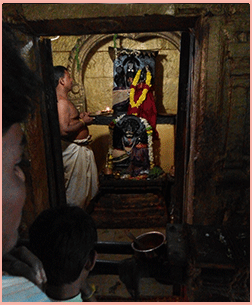 It is conveniently accessible by bus from Nandyal, Kurnool and Hyderabad. Ahobilam is not connected by rail; the closest railway stations are Nandyal (on the Bangalore–Vizag(Visakhapatnam) route) and Cuddapah (on the Mumbai–Chennai route). There are three routes reaching Ahobilam. Pilgrims from the north can get down at Nandyal, which is a Railway junction from Kurnool, and travel by bus to Allagadda and Ahobilam, which is only thirty miles from Nandyal. The second route is from Dhone which is another railway station and from which one can reach Ahobilam via Banganapalle and Koilkuntla.
It is conveniently accessible by bus from Nandyal, Kurnool and Hyderabad. Ahobilam is not connected by rail; the closest railway stations are Nandyal (on the Bangalore–Vizag(Visakhapatnam) route) and Cuddapah (on the Mumbai–Chennai route). There are three routes reaching Ahobilam. Pilgrims from the north can get down at Nandyal, which is a Railway junction from Kurnool, and travel by bus to Allagadda and Ahobilam, which is only thirty miles from Nandyal. The second route is from Dhone which is another railway station and from which one can reach Ahobilam via Banganapalle and Koilkuntla.
The other and easy route is to get down at Kadapa which is a district headquarters and an important railway station in the Madras – Bombay route. From Cuddapah one has to travel to Allagadda, which is forty miles over and from there by bus to Ahobilam.
Ahobhilam also known as Ahobalam is located in the Allagadda mandal of Kurnool district in Andhra Pradesh, India. It is located at a distance of 70 km from Nandyal and about 150 km from Kurnool, and about 400kms from Bangalore.
According to the puranas, this is the very spot where Narasimha blessed Prahlada and killed the demon Hiranyakashipu.
Aho is an exclamation word. Bhalam (bhalam means energy). It is equivalent of ‘oh the mighty energy’ and thus aho-bhalam of lord Narasimha swamy. One famous slokam that explains this is:
Aho veeryam! aho shouryam! aho baahu parakrama!
Naarasimham param deivam aho bhilam! aho balam!
Meaning: Oh! what a great valour he has! oh his great gallantry! oh those great powerful shoulders of the greatest of the Gods Lord Narasimha, and what a mighty cave it is! and what a mighty divine strength He has!
The temple
Nava Narasimha Kshetram 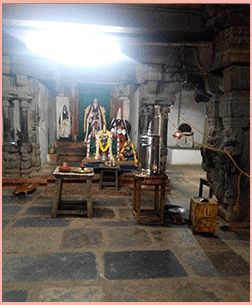
Goddess Name: Amritavalli (Lakshmi devi)
Pushkarni: Indra Pushkarni
Vimanam: Vimanam Guha Vimanam
- Yogananda Narasimha (Shani)
- Jwala Narasimha (Kuja)
- Bhargava Narasimha (Surya)
- Chatravata Narasimha (Chandra)
- Varaha Narasimha (Rahu)
- Malola Narasimha (Ketu)
- Paavana Narasimha (Buda)
- Karanja Narasimha (Shukra)
- Ugra Narasimha (Guru)
Lower Ahobilam Temple Gopuram
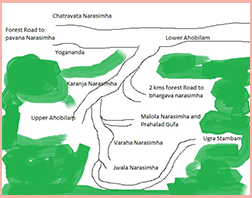 There are nine temples around the Nallamala Forest range, and in terms of sculpture and architecture all these nine temples stands to be an ultimate testament for the ancient sthapathis in planning and sculpting these temples. A few temples can be reached through trekking. Some temples are inside the cave. Some temples are very difficult to trek to. The nine planets that define the human fates are believed to have worshipped these nine Lord Narasimhas to get relief from Rakshashas (demons) and curses of sages for their actions. This is main theme of the work of the great Telugu poet Errana, the “Nrisimha Puranam”. The hereditary powers of the temple rest with the Pontiff HH Azhagiyasingar of Ahobila Mutt. Currently the 45th Jeeyar of this lineage is the reigning Pontiff. Occasionally when HH Jeeyar performs Mangalasasanam (pays respects at the temple) at Ahobilam, the Serthi Utsavam is performed (the Moolavar of Malola Nrusimhar and the Utsavar) are united.
There are nine temples around the Nallamala Forest range, and in terms of sculpture and architecture all these nine temples stands to be an ultimate testament for the ancient sthapathis in planning and sculpting these temples. A few temples can be reached through trekking. Some temples are inside the cave. Some temples are very difficult to trek to. The nine planets that define the human fates are believed to have worshipped these nine Lord Narasimhas to get relief from Rakshashas (demons) and curses of sages for their actions. This is main theme of the work of the great Telugu poet Errana, the “Nrisimha Puranam”. The hereditary powers of the temple rest with the Pontiff HH Azhagiyasingar of Ahobila Mutt. Currently the 45th Jeeyar of this lineage is the reigning Pontiff. Occasionally when HH Jeeyar performs Mangalasasanam (pays respects at the temple) at Ahobilam, the Serthi Utsavam is performed (the Moolavar of Malola Nrusimhar and the Utsavar) are united.
The Nallamala hills are personified as Adisesha with his head at Tirumala, middle at Ahobilam and the tail at Srisailam.
Legend
According to legends it is believed that when the Devas saw the manifestation of Lord Vishnu as half-lion, half-man, they shouted “Ahobala” (great strength) as well as “Ahobila” (great cave in which the current sanctum is). Hence, this place could be called either “Ahobalam” or “Ahobilam”. The mention of this place is present in Brahmanda Purana. The place where Lord Narayana appeared from the stone pillar to kill Hiranyakashipa can be seen in this place. The name of this pillar is Ugra Sthambha, which is now referred as “Ukku SThambha” in Telugu, which incorrectly translates to iron pillar.Diguva and Eguva (Lower and upper Ahobilas)
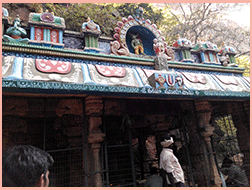 In the lower Ahobila Lakshmi Narasimha Swami is in a peaceful form. The temple has exquisite stone art. The history of Ahobila temple is sculptured in the stone form. Lord Srinivasa himself is said to installed the main deity here. He is said to have sought the blessings of Narasimha before his wedding but finding the Narasihma in fierce form in Upper Ahobila, he is said to have installed the peaceful form in the lower Ahobila. The temple complex also had temples for Adivan Sathagopulu. The sculptures of coronation of Lord Srirama (Sreerama Pattabhishekha), the ten incarnation of Lord Vishnu (Dasavatharas), statues of Poet Annamacharya are present on the walls of the temple. Annamacharya is said to have spent some time here composing songs praising the Lord Narasimha. The great sage Lord Pothuluri Veerabrahmendra Swamy is said to have meditated here to write Kalagnana (the knowledge of the future) which set forth a spiruitual movement. It is a common practice to worship the Prahlada Varada Narasimha (the Narasimha who gave boons to Prahlada) in lower Ahobilam before worshipping Eguva (Upper) Ahobila Narasimha, who is present eight kilometers away on a hilltop inside a cave. After worshipping the Lord, it is another practice to visit Navanarasimhas (nine Narasimhas). The legend says Lord Narasimha, after slaying Hiranyakasipa was roaming around the forest hills of Ahobilam making fearsome laughs and settling at nine places to bless the devotees. Here are the Nava Narasimha temples. Another legend describes when Lord Garuda did penance to see Lord Vishnu in Lord Narasimha form. Thereafter, LordNarasimha took nine different forms in this hill.
In the lower Ahobila Lakshmi Narasimha Swami is in a peaceful form. The temple has exquisite stone art. The history of Ahobila temple is sculptured in the stone form. Lord Srinivasa himself is said to installed the main deity here. He is said to have sought the blessings of Narasimha before his wedding but finding the Narasihma in fierce form in Upper Ahobila, he is said to have installed the peaceful form in the lower Ahobila. The temple complex also had temples for Adivan Sathagopulu. The sculptures of coronation of Lord Srirama (Sreerama Pattabhishekha), the ten incarnation of Lord Vishnu (Dasavatharas), statues of Poet Annamacharya are present on the walls of the temple. Annamacharya is said to have spent some time here composing songs praising the Lord Narasimha. The great sage Lord Pothuluri Veerabrahmendra Swamy is said to have meditated here to write Kalagnana (the knowledge of the future) which set forth a spiruitual movement. It is a common practice to worship the Prahlada Varada Narasimha (the Narasimha who gave boons to Prahlada) in lower Ahobilam before worshipping Eguva (Upper) Ahobila Narasimha, who is present eight kilometers away on a hilltop inside a cave. After worshipping the Lord, it is another practice to visit Navanarasimhas (nine Narasimhas). The legend says Lord Narasimha, after slaying Hiranyakasipa was roaming around the forest hills of Ahobilam making fearsome laughs and settling at nine places to bless the devotees. Here are the Nava Narasimha temples. Another legend describes when Lord Garuda did penance to see Lord Vishnu in Lord Narasimha form. Thereafter, LordNarasimha took nine different forms in this hill.
Nine(Nava) Narasimhas
Lord Narasimha in nine forms areBhargava Narasimha Swamy
This Lord is present on a hillock at a distance of 2.5 km from Lower Ahobilam, with Akshaya (inexhaustible) thertha (lake). Lord Parsurama is said to have performed penance for Lord Narasimha. An worship of the Lord after a bath in the Akshaya Theertha would make the Lord give Lakshmikara (hand possessing Goddess Lakshmi or prosperity) thus blessing in all manners.Yogananda Narasimha Swamy
This place is suitable for meditation. Prahlada is said to have obtained all the prosperity after meditating upon the Lord here. The compassionate Lord here rescues the people who seek help out of difficulties.Chatravata Narasimha Swamy
One of the astrological planets, Ketu is said to have worshipped the Lord here and gained all comforts. People willing to study fine arts seek blessings from this Lord.Ahobila (Ugra) Narasimha Swamy
This is the main Lord of all Nava Narasimha’s and is also referred as the main temple in Upper Ahobilam. Goddess Chenchu (local forest tribe who have been ardent worshippers of the Lord for ages) Lakshmi is with the Lord. Heart-felt prayer to the lord destroys all fear and timidness.Located at a distance of 1 km from Upper Ahobilam,Present with the divine consort Lakshmi, Lord removes the obstacles and ensures success to the worshippers.This temple is also referred as
Kroda Narasimha swamy
The statue is in side a small rock cut formation facing the perennial stream of water.Malola Narasimha Swamy
This temple is present in Lakshmi Parvata (Hill). Goddess Sri Mahalakshmi along with the Lord, bestows blessing on the devotees. Worshipping this Lord brings Brahmananda (unlimited joy) to this world and the higher world.Jwala Narasimha Swamy
Lord Narsimha appears fierce slaying Hiranyakasipa with his nails. Serving the Lord ensures success in all efforts, marriages are made. Lighting a ghee lamp in the month of the Karthika and meditating on Lord dispels all sins and brings fame and name. This temple is the toughest to reach compared to other Narasimha temples. A small red water pond named “Raktha Gunda Theertham” can be seen on the way to the temple which is said to be the place where Narasimha swamy washed his hands after slaying the Demon.Paavana Narasimha Swamy
This is said to be the most peaceful form among the Nava Narasimha Kshetras. This is said to Kshetra Ratna (jewel among the Kshetras)and is also referred as Pamuleti Narasimha swamy. Sages have said that the Lord here liberates the devotees from all the sins in the past lives and sins in the current life (knowingly or unknowingly).Karanja Narasimha Swamy
Serving the Karanja Swamy with three austerities (thought, word and action) brings enlightenment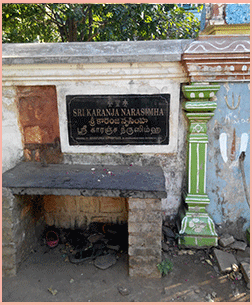 and the Lord bestows all desires.
and the Lord bestows all desires.
Every year, in the month of Phalguna Brahmotsavas (ceremonies performed by the Lord Brahma) are held. Apart from this, every month, on the star day of the Lord, which is Swathi, Gramotsavas (village ceremonies) are celebrated. On that day, Thirumanjan Seva (service) is performed with 108 Kalasas(holy vessels) grandly, A lot of pilgrims visit the temple on the auspicious Swati nakshatra day.
Each of these nine forms have a beautiful story woven with strands of myth, fancy legends and epic tales. According to popular belief, one form of the Lord, the Pavana Narasimhaswamy, when offered the prasad returns half of the offering back to the devotee. On these lines, the Jwala Narasimhaswamy is supposed to be the ferocious form. This form personifies the cumulative and intense anger of the God. It is believed that the original site of shrine of Jwala Narasimhaswamy was the mouth of a volcano and it is only the proxy shrine which is accessible to the devotees.
Belief is that the navagrah’s attained their power of being the planet by worshiping these deities of Narashimha. It is believed that the people having malefic effect of any planet could get some reprieve by worshiping Narasimha.
Legend also states that Goddess Mahalakshmi took birth as a human in a tribe, named Chenchu Lakshmi and married Lord Narasimha after the death of Hiranyakashpu.Narasimha Jayanthi will be celebrated with pomp and glory. The local tribals celebrate the marriage of Goddess Mahalakshmi as ChenchuLakshmi and Lord Narasimha.
The contact person in Ahobilam is Sri. Shiva Shankar who is a guide and an assistant from hariharapuram. Shiva Shankar who stays in Allagadda.
Contact: Phone: 08106025197
Temple E.O is Sri Ramanuja Acharya and his contact details are as follows
0-9440306907 and 0-94407 25936 and temple number (best option) 08519 252025 Email id :- rjsmrgbureau@gmail.com.
The main Archaka is called Venugopalaswamy.
For general email enquiry please contact perepurao@yahoo.com or gmail.com He is a devotte of Sri Swayamprakasha swamiji staying in Gudur and will respond with requisite details.
Divya Kshetra
- Ahobila
- Kadiri
- Simhachalam
- Mangalagiri
- Yadagiri Gutta
- Vedadri
- Antarvedi
- Vadapalli
- Kethavaram
- Narasimha Konda
- Mattapalli
- Melkote
- DevarayanDurga
- Hariharapuram
- Saligrama
- Jharni
- Seebi
- Pataladri
- Kadighachalam
- Naamakkal
- Anthili
- Parikkal
- Poovarasankuppam
- Sinirkudi
- Thiruvadigai
- Kole
- Indapur
- Pokharni
- Marjāra
- Puri
- Narasingapalli
- Jyothir Mutt
